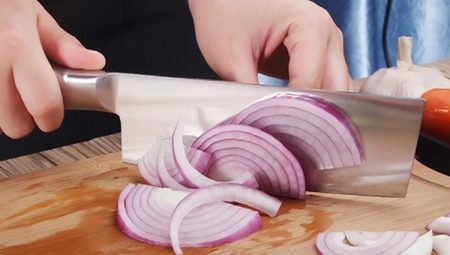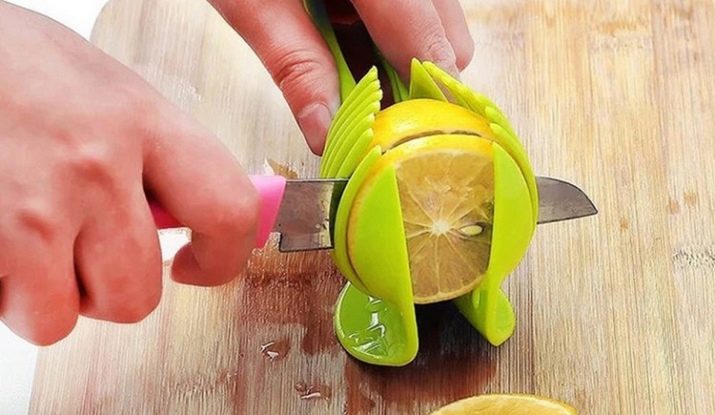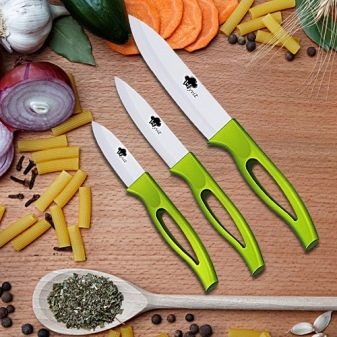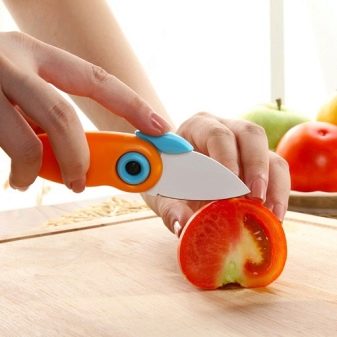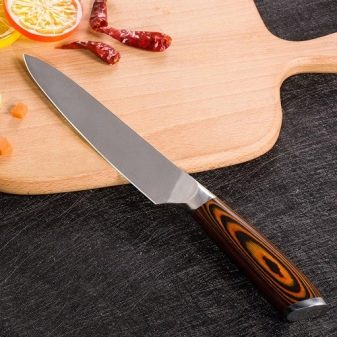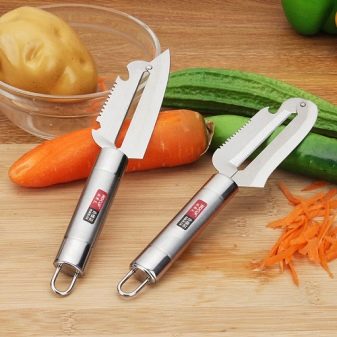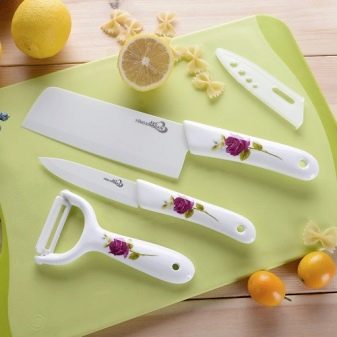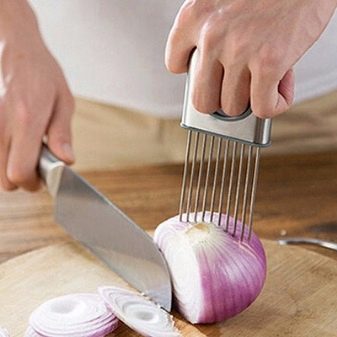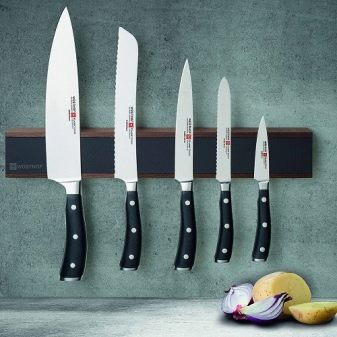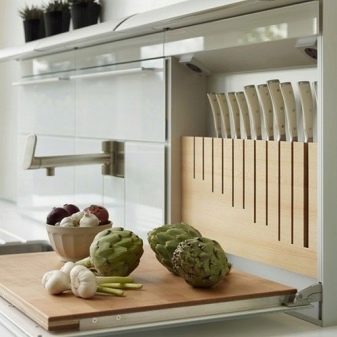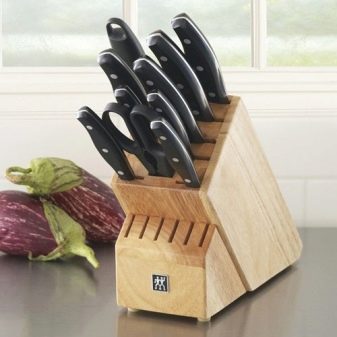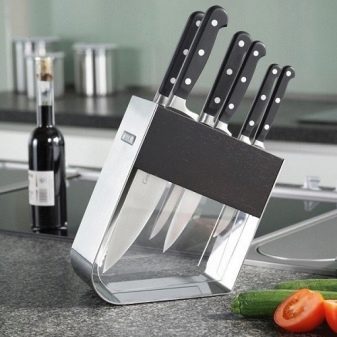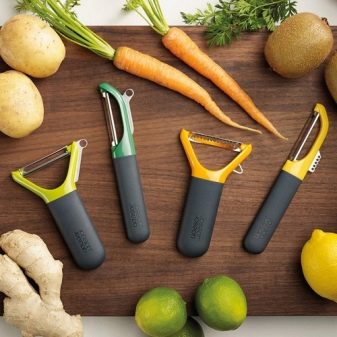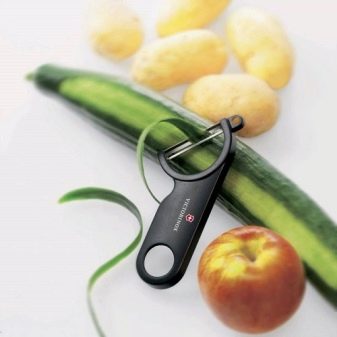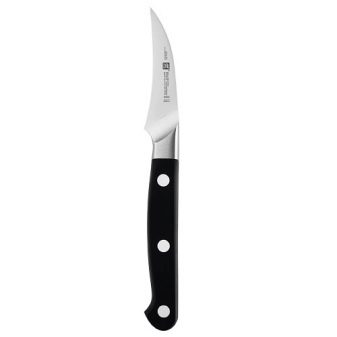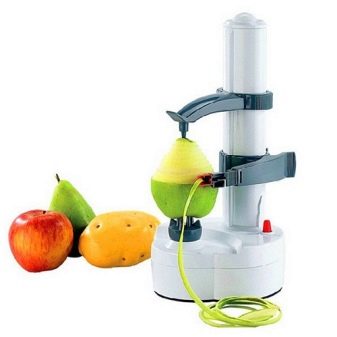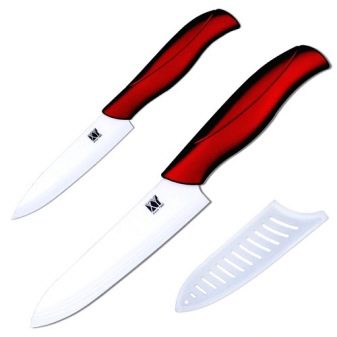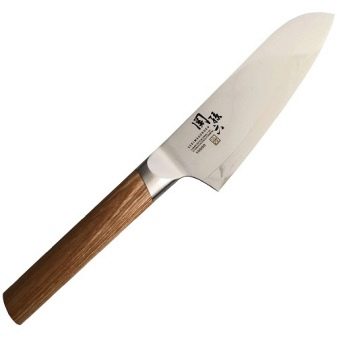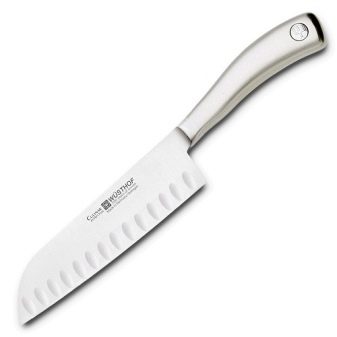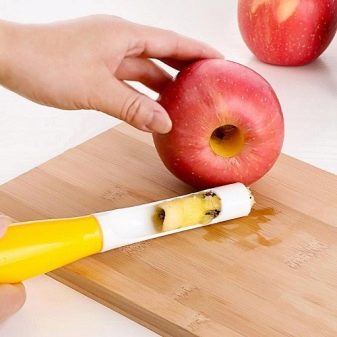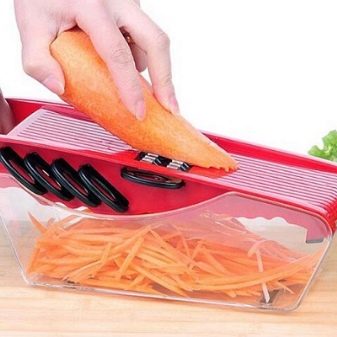Experienced housewives and professional chefs know how good it is to have different knives on hand. Each of them is designed for a specific type of work. And even if you do not consider it necessary to buy a whole set of professional knives for each type of cutting, then it is simply necessary to have several copies. After all, for cutting vegetables, meat or bread must be individual tools. This rule is dictated by elementary standards of hygiene.
Features
It is very difficult to give a single description of all existing types of knives for cutting vegetables and fruits. They differ in shape, size and intended purpose. This is their main feature.
In addition, any vegetable or fruit knife should have the following parameters.
- Small size. A big bulky item would be very inconvenient to cut small fruits. The only exceptions are large vegetables (pumpkin, zucchini). Also, short knives become unsuitable for cutting watermelon or melon.
- Sharp thin blade. This requirement applies to almost all knives for vegetables. These products do not have such a dense structure, like meat, and we do not cut them frozen.
Therefore, a thin blade helps to quickly and beautifully cut fruit.
Materials
Like any other knife, this kitchen assistant consists of two parts - the blade and the handle. At the same time, the materials of the first and second components can be completely different. Manufacturers offer various options and combinations of materials in one product.
Blade material
Traditionally, the manual knife for cutting vegetables was made from metal. Zinc or stainless steel is used as raw material. Today, ceramic models have become very popular. They have their advantages and disadvantages.
Ceramics do not have such flexibility as metal. It will be convenient for them to make straight cuts (when cutting onions, potatoes, apples). If you need to maneuver when cutting or cut a rough skin from a vegetable of irregular shape, it is better to use a metal one. From the advantages of the same ceramic can be noted the sharpness of the blade, antibacterial properties. Odors are not absorbed into it and the risk of bacteria multiplication is minimal on the surface.
But many housewives, having tried ceramic knives, still return to the usual metal tools. This is also explained by the fact that the probability of an object breaking during a shock is high.
They are afraid of a sharp temperature drop.
How to use
The service life of any kitchen object depends largely on how it was used.
This concept includes the following parameters.
- Frequency of use. Obviously, in a family where there are 2-3 children, cook more often than in the kitchen of a bachelor. Therefore, with frequent use, it is advisable to purchase several items at once for a different type of work with vegetables. Each of them will serve you longer than one, if you only do all the work for them.
- Use as directed. This type of knives has thin and sharp blades and is not suitable for rough work. When slicing frozen or just very solid foods, it quickly becomes dull and will become unusable.
- It is important to properly hold the knife when working. Especially this rule applies to ceramic models. If you work on them for kink, then the blade plane can break. This is due to the low flexibility of the material. But the metal knife must be used correctly.Do not strike, and do not push it with force.
- It is better to cut the products on a wooden or plastic cutting board. A sharp blade can quickly become blunt from contact with hard surfaces such as glass and marble. Today, manufacturers offer to purchase and flexible silicone chopping boards. They are very convenient, after cutting, you can bend the edges and easily move the vegetables into a container.
- If you want to surprise guests not only with the taste of their dishes, but also with their beauty, then purchase special knives. For example, a core knife will help rid apples and pears from seeds, and the appearance will remain attractive.
- Beautiful cutting is obtained using figured knives. Their blades can be wavy, have teeth or another pattern on the blade. With their help, you can create real masterpieces of simple vegetables and fruits. Will appreciate such creativity and kids. They with great pleasure will eat a beautiful slice of fruit, than that which is cut in the usual way.
Care and storage
Kitchen knives should be kept in a separate place. In this case, do not forget about safety, if the house has small children. They should not have access to these dangerous items.
You can put knives in a special compartment in the organizer for kitchen utensils. In this case, it is desirable that the blades (especially metal) of the knives do not touch each other. Another option could be a magnetic board, to which the whole set of knives you have will be attached.
But this option is not suitable for ceramic copies.
A universal option will be a special stand. It has separate holes for each item. The blade is placed in one of the compartments, and the handle sticks out from above. This is the safest and most convenient way to store. The entire set will be freely available, and it will not interfere. The risk of getting cuts is also minimal, since in order to get the object you take it by the handle. Also important is the fact that the blades will not touch, which means that they will not appear scratches and notches.
Wash the knives after each use.
Both metal and ceramic specimens must be carefully wiped with a towel before being placed in storage space.
Kinds
There are many types of knives for vegetables. They differ in shape, size, purpose and materials. But at the same time they can be divided into several groups.
- For cleaning. They can also be divided into several subspecies. The first looks very much like a razor, only the blades are longer. It is worth noting that they are parallel to each other and are very thin and sharp. With this tool, you can easily peel carrots, beets and other round root vegetables. But not all housewives convenient to peel potatoes because of its irregular shape. Often a potato knife has the appearance of the usual, only with a shorter blade.
Today, you can often see peelers, which have blades at both ends. One is used for cleaning, the other can be cut curly slices. In the middle, the object is equipped with a small plastic grater. Most often it is used for lemon peel. Therefore, it can be argued that this product is 3 in 1.
There is also a more classic model of a knife for cleaning. In English, it is called the peeling knife. It has a rather short blade, up to 10 cm. At the same time, it is curved, which facilitates the process of removing the skins from vegetables and fruits.
Currently, electric peelers can be found. They greatly simplify the whole process.
Whether you need such an assistant or you will only have a classical model depends on how often and how much you cook.
- Universal. Such a knife is always useful in the kitchen. It has an average length blade, sharpened on both sides. This aspect makes it universal for use, both for left-handers and right-handers.The knife has a thin sharp blade, so it is very easy for them to chop soft and harder fruits. It is worth noting that for such vegetables as tomato, it is better to use specimens with small teeth.
They will easily cut the peel and just cut the flesh, and not squeeze it.
- Santoku. This Japanese knife won the hearts of not only housewives, but also professional chefs. In addition to visual appeal, it has excellent characteristics. The blade and the handle are perfectly balanced, so it is very convenient to work with them. The weight of the blade does most of the work for you, almost without forcing an effort. Another undoubted advantage of it is universality.
It can equally cut both mango and chicken fillet.
- To cut the cavity. Everyone knows how difficult it is to cut the core of an apple or pear with a regular cook knife. Then these little helpers come to the rescue. They have a cylindrical shape with pointed edges. You will only need to attach to the tail of the apple and press down. As a result, the entire core will remain inside the cylinder. You can also use it to create beautiful compositions on the holiday table. Currently, not every housewife in the kitchen can see such a knife. In the kitchens of the same catering points it has long been appreciated and used, since cooking time is of great importance there.
By the same type can be attributed knife for stuffing. It has the same shape, but is screwed into the vegetable, removing the cavity. The cut fragment is obtained in the form of a spiral.
- Slicer. They can be presented as a single item, or as a whole set of devices (multi-slicer). Outwardly, it may resemble a grater. Some models are equipped with a container for collecting the cut product. These devices provide a truly unlimited possibilities of working with vegetables. With their help, you can beautifully chop vegetables for serving. Very quickly and effortlessly cut the fruit into cubes. There are also some items with which you will rub or slice potatoes and other vegetables.
How to choose
Before you go to the store for a knife, decide on the parameters which are important when choosing.
- Purpose Will this knife be used for cutting or do you need a peeler.
- The size. With this option, you can decide directly in the store. Hold the goods in your hands, imagine how you wield them in your kitchen. Choose the model that seemed most comfortable.
- Material. The choice will have to do between ceramic and metal blades.
Knives for vegetables and fruits have a different shape and size. They are indispensable in the kitchen and greatly facilitate the process of cooking.
Choose the one that suits you, and cook with pleasure.
To learn how to sharpen a knife for vegetables, you can find out by looking at the video a little lower.
